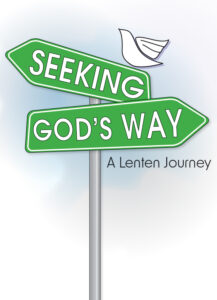 Talashia Keim Yoder is the author of this year’s Lent at Home guide. She is a pastor at College Mennonite Church in Goshen, Indiana, and lives in Goshen with her husband, Daniel, and their two sons. Talashia is passionate about exploring faith at home and in other intergenerational settings. Talashia is also the theater director at Bethany Christian Schools and the founder and content writer behind “This is the Story” (godsstorygodssong.com) and Building Faith (buildingfaithfamily.com).
Talashia Keim Yoder is the author of this year’s Lent at Home guide. She is a pastor at College Mennonite Church in Goshen, Indiana, and lives in Goshen with her husband, Daniel, and their two sons. Talashia is passionate about exploring faith at home and in other intergenerational settings. Talashia is also the theater director at Bethany Christian Schools and the founder and content writer behind “This is the Story” (godsstorygodssong.com) and Building Faith (buildingfaithfamily.com).
Download the 2022 Lent at Home guide and resources here.
_______________________________________________
“Whaat? It’s still Lent?” It was our first time doing a daily Lenten ritual as a family, and five weeks in, our then-five-year-old had had enough. Our family loved the Advent ritual of candle lighting, and we naively assumed Lent would be just as beloved. Wrong. It felt like a long, long slog.
When we stepped back and took a look, it made sense. Lent is long, for one thing. Forty days, to be precise, but it feels even longer, because Sundays aren’t part of the 40 days (They’re little Easters, which I kind of love). Instead of lighting more and more candles, we light fewer, which (especially for those among us who love lighting and blowing out candles) can be kind of a downer. And Advent, while infused with a sense of awe and mystery, lends itself to playful celebration — we move toward the birth of Jesus, telling the story of miraculous birth over and over. Lent, on the other hand, moves toward death. I mean, resurrection closely follows, but first comes death. Put all of this together, and Lent can get a little hard to take.
When John-Michael Tebelak was working on his master’s thesis at Carnegie Mellon University in 1970, he became fascinated with the joy of the Gospels. Following this joy, he made his way to an Easter vigil service at a church. He left with a feeling of emptiness, and that drove him to write something that would reclaim the joy of the story. The result? The script for the musical “Godspell.”
There is deep and abiding joy in the journey of Lent. The life and teachings of Jesus have moments of humor, moments to play with and, when put together, they lead to a more joy-filled life.
Cleaning out our lives can be literal, and doing it brings a sense of relief and openness. Coming into alignment with the call of Jesus is, ultimately, the fullest life we can live. And then there’s confession, which begins Lent and is a continuing theme throughout it. In Tebelak’s (and Stephen Schwartz’s) “Godspell,” the song of confession is “We Beseech Thee,” a show-stopping frolic of a song that leads straight into the Last Supper. Confession is so much more than admitting guilt. It’s authenticity. We confess love for others and our limitations and our beautiful humanness, right alongside our sins. That kind of truth-telling brings release. Freedom. Joy.
 In this year’s Lent At Home resource, I have attempted to pull all of these musings together into a balanced rhythm. Rituals bookend the season, and these rituals are a mix of playfulness (bubble blowing, anyone?) and solemnity. Between the rituals is a calendar to guide you through the season. Some days offer a scripture passage and a simple reflection question. On other days, you’ll be invited to shout, count stars, bake or go for a walk. There’s also a weekly (Sunday — little Easter!) reminder to worship God in community. We humans are created for community, and it’s often in community that we are transformed. The candle ritual is still there, reminding us of the holy walk with Jesus. And the diminishing light will make the brilliance of Easter’s sunrise that much more joyful.
In this year’s Lent At Home resource, I have attempted to pull all of these musings together into a balanced rhythm. Rituals bookend the season, and these rituals are a mix of playfulness (bubble blowing, anyone?) and solemnity. Between the rituals is a calendar to guide you through the season. Some days offer a scripture passage and a simple reflection question. On other days, you’ll be invited to shout, count stars, bake or go for a walk. There’s also a weekly (Sunday — little Easter!) reminder to worship God in community. We humans are created for community, and it’s often in community that we are transformed. The candle ritual is still there, reminding us of the holy walk with Jesus. And the diminishing light will make the brilliance of Easter’s sunrise that much more joyful.
The theme for the resource, “Seeking God’s Ways,” aligns with the worship guide offered in “Leader” magazine. It encourages us to take an open-minded look at scripture. As we seek God’s ways, we discover the twists, turns, flips and deepening that Jesus can bring to what we think we know. This Lenten season, discover the joy, release and openness that can come when we truly seek the way of Jesus.

